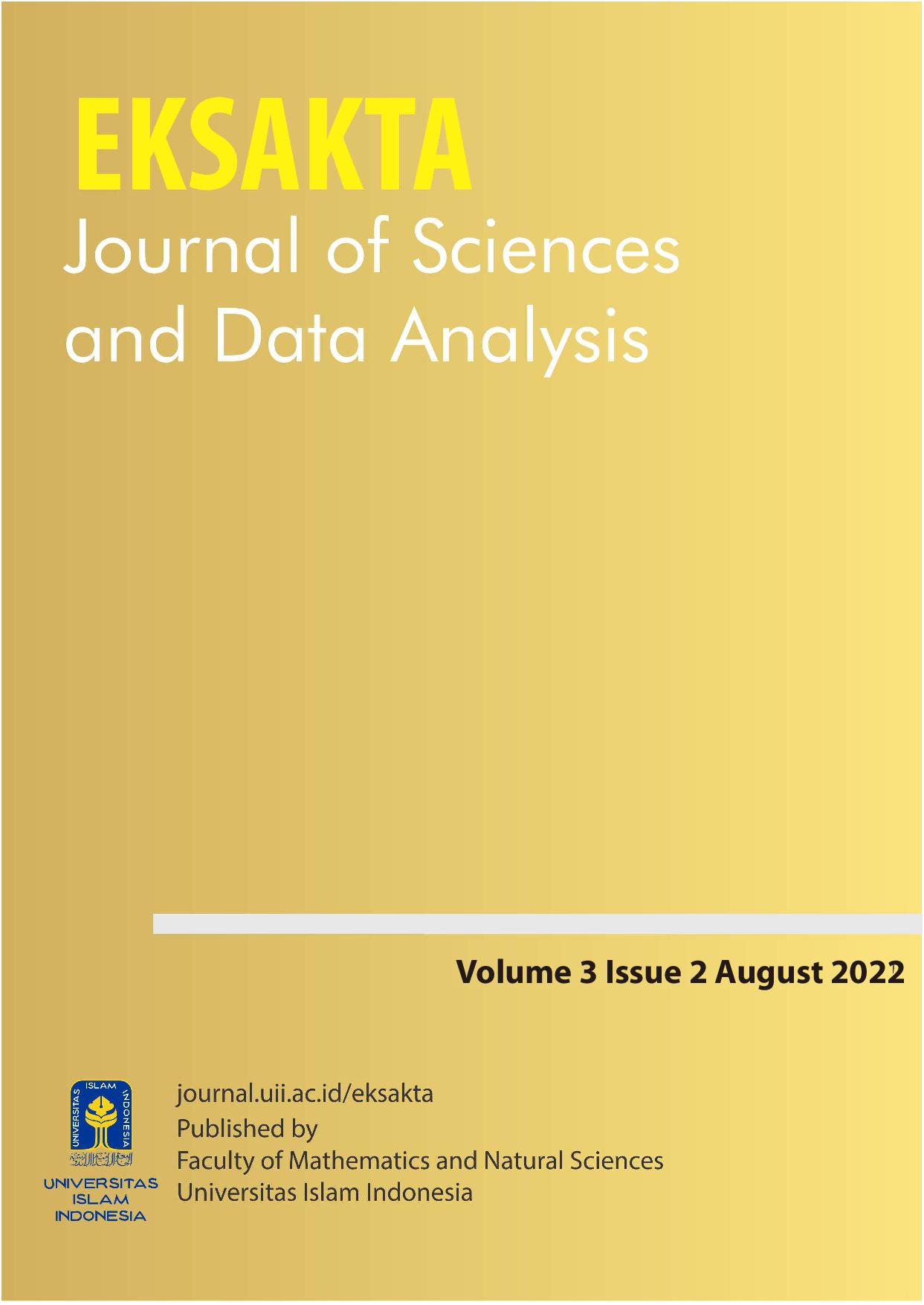Main Article Content
Abstract
The deadliest infectious disease in Indonesia is tuberculosis (TB), and South Sulawesi is one of the provinces that contributed the most tuberculosis cases in Indonesia in 2018 with 84 cases per 100,000 population. This study aims to identify variables that could explain the proportion of TB cases in South Sulawesi. The data used has many explanatory variables, and there are outliers. Sparse Least Trimmed Squares (LTS) analysis can be used to handle data that has many explanatory variables and outliers. The resulting sparse LTS model successfully selects and shrinks the variables to 14 variables only. In addition, based on the value of R2 and RMSE for the model evaluation, the sparse LTS shows satisfying results rather than classical LASSO. The government can focus on these factors if they want to reduce the proportion of TB cases in South Sulawesi.
Keywords
Article Details
Authors who publish with this journal agree to the following terms:
- Authors retain copyright and grant the journal right of first publication with the work simultaneously licensed under a Creative Commons Attribution License that allows others to share the work with an acknowledgment of the work's authorship and initial publication in this journal.
- Authors are able to enter into separate, additional contractual arrangements for the non-exclusive distribution of the journal's published version of the work (e.g., post it to an institutional repository or publish it in a book), with an acknowledgment of its initial publication in this journal.
- Authors are permitted and encouraged to post their work online (e.g., in institutional repositories or on their website) prior to and during the submission process, as it can lead to productive exchanges, as well as earlier and greater citation of published work (See The Effect of Open Access).
References
- World Health Organization, Global tuberculosis report 2018, 2018.
- Badan Pusat Statistik Sulawesi Selatan, Provinsi Sulawesi Selatan Dalam Angka 2018, 2019.
- Badan Penelitian dan Pengembangan Kesehatan, Laporan Provinsi Sulawesi Selatan Riskesdas 2018, 2019.
- Kementerian Kesehatan Republik Indonesia, Profil Kesehatan Indonesia 2020, 2021.
- Badan Pusat Statistik Sulawesi Selatan, Provinsi Sulawesi Selatan Dalam Angka 2020, 2021.
- R. Tibshirani, Regression shrinkage and selection via the lasso, J. R. Stat. Soc. Series B., 58(1) (1996) 267-288.
- A. Alfons, C. Croux, S. Gelper, Sparse least trimmed squares of analyzing high-dimensional large data sets, Ann. Appl. Stat., 7(1) (2013) 226-248.
- A. Sejati, L. Sofiana, Faktor-faktor terjadinya tuberkulosis, KEMAS: Jurnal Kesehatan Masyarakat, 10(2) (2015) 122-128.
- Y. A. Mait, D. T. Salaki, H. A. Komalig, Kajian model prediksi metode least absolute shrinkage and selection operator (lasso) pada data mengandung multikolinearitas, d'CARTESIAN: Jurnal Matematika dan Aplikasi, 10(2) (2021) 69-75.
- E. Yang, A. C. Lozano, A. Aravkin, A general family of trimmed estimators for robust high-dimensional data analysis, Electron. J. Stat., 12(2) (2018) 3519-3553.
- A. Hoerl and R. Kennard, Ridge regression: Biased estimation for nonorthogonal problems, Technometrics, 12(1) (1970) 55-67.
- Y. Z. Liang, O. M. Kvalheim, Robust methods for multivariate analysis-a tutorial review, Chemom. Intell. Lab. Syst., 32(1) (1996) 1-10.
- Y. Z. Liang, K T. Fang, Robust multivariate calibration algorithm based on least median of squares and sequential number theory optimization method, Analyst, 121(8) (1996) 1025-1029.
- R. Maronna, R. Martin, V. Yohai, Robust Statistics: Theory and Methods, John Wiley & Sons, New York, 2006.
- P. Rousseeuw and A. Leroy, Robust Regression and Outlier Detection, 2nd edition, John Wiley & Sons, New York, 2003.
- P. J. Rousseeuw, Least median of squares regression, J. Am. Stat. Assoc., 79(388) (1984) 871–880.
- P. J. Rousseeuw and K. Van Driessen, Computing LTS regression for large data sets, Data Min. Knowl. Discov., 12(1) (2006) 29–45.
- C. Sammut and G. I. Webb, Eds., Mean Squared Error, in Encyclopedia of Machine Learning, Boston, MA: Springer US, 2010, pp. 653.
- D. Rosadi, Analisis statistika dengan R, 1st ed., Gadjah Mada University Press, Yogyakarta, 2016.
References
World Health Organization, Global tuberculosis report 2018, 2018.
Badan Pusat Statistik Sulawesi Selatan, Provinsi Sulawesi Selatan Dalam Angka 2018, 2019.
Badan Penelitian dan Pengembangan Kesehatan, Laporan Provinsi Sulawesi Selatan Riskesdas 2018, 2019.
Kementerian Kesehatan Republik Indonesia, Profil Kesehatan Indonesia 2020, 2021.
Badan Pusat Statistik Sulawesi Selatan, Provinsi Sulawesi Selatan Dalam Angka 2020, 2021.
R. Tibshirani, Regression shrinkage and selection via the lasso, J. R. Stat. Soc. Series B., 58(1) (1996) 267-288.
A. Alfons, C. Croux, S. Gelper, Sparse least trimmed squares of analyzing high-dimensional large data sets, Ann. Appl. Stat., 7(1) (2013) 226-248.
A. Sejati, L. Sofiana, Faktor-faktor terjadinya tuberkulosis, KEMAS: Jurnal Kesehatan Masyarakat, 10(2) (2015) 122-128.
Y. A. Mait, D. T. Salaki, H. A. Komalig, Kajian model prediksi metode least absolute shrinkage and selection operator (lasso) pada data mengandung multikolinearitas, d'CARTESIAN: Jurnal Matematika dan Aplikasi, 10(2) (2021) 69-75.
E. Yang, A. C. Lozano, A. Aravkin, A general family of trimmed estimators for robust high-dimensional data analysis, Electron. J. Stat., 12(2) (2018) 3519-3553.
A. Hoerl and R. Kennard, Ridge regression: Biased estimation for nonorthogonal problems, Technometrics, 12(1) (1970) 55-67.
Y. Z. Liang, O. M. Kvalheim, Robust methods for multivariate analysis-a tutorial review, Chemom. Intell. Lab. Syst., 32(1) (1996) 1-10.
Y. Z. Liang, K T. Fang, Robust multivariate calibration algorithm based on least median of squares and sequential number theory optimization method, Analyst, 121(8) (1996) 1025-1029.
R. Maronna, R. Martin, V. Yohai, Robust Statistics: Theory and Methods, John Wiley & Sons, New York, 2006.
P. Rousseeuw and A. Leroy, Robust Regression and Outlier Detection, 2nd edition, John Wiley & Sons, New York, 2003.
P. J. Rousseeuw, Least median of squares regression, J. Am. Stat. Assoc., 79(388) (1984) 871–880.
P. J. Rousseeuw and K. Van Driessen, Computing LTS regression for large data sets, Data Min. Knowl. Discov., 12(1) (2006) 29–45.
C. Sammut and G. I. Webb, Eds., Mean Squared Error, in Encyclopedia of Machine Learning, Boston, MA: Springer US, 2010, pp. 653.
D. Rosadi, Analisis statistika dengan R, 1st ed., Gadjah Mada University Press, Yogyakarta, 2016.




